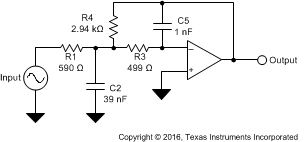SBOS365G may 2006 – may 2023 OPA2365 , OPA365
PRODUCTION DATA
- 1
- 1 Features
- 2 Applications
- 3 Description
- 4 Revision History
- 5 Device Comparison Table
- 6 Pin Configuration and Functions
- 7 Specifications
- 8 Detailed Description
- 9 Application and Implementation
- 10Device and Documentation Support
- 11Mechanical, Packaging, and Orderable Information
Package Options
Mechanical Data (Package|Pins)
- D|8
Thermal pad, mechanical data (Package|Pins)
Orderable Information
9.2 Typical Application
Low-pass filters are commonly employed in signal processing applications to reduce noise and prevent aliasing. The OPAx365 are designed to construct high-speed, high-precision active filters. Figure 9-3 illustrates a second-order low-pass filter commonly encountered in signal processing applications.
 Figure 9-3 Second-Order Low-Pass Filter
Figure 9-3 Second-Order Low-Pass Filter